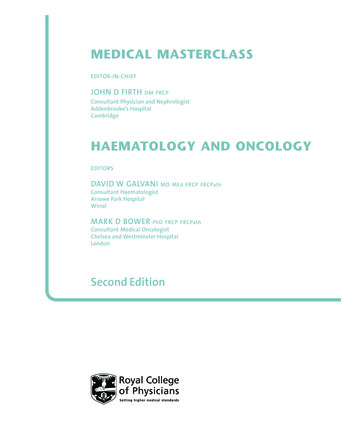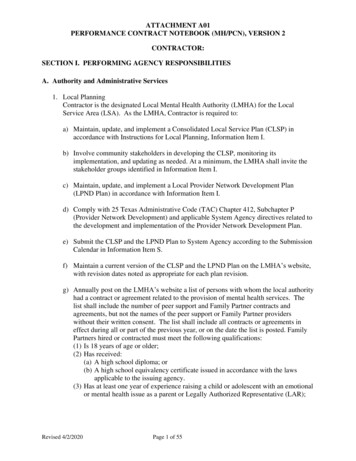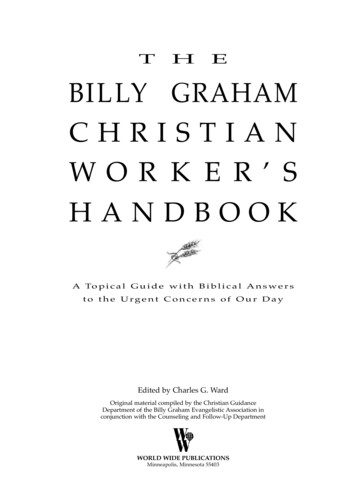
Transcription
HAO A0112/15/1010:19Page iMEDICAL MASTERCLASSEDITOR-IN-CHIEFJOHN D FIRTHDM FRCPConsultant Physician and NephrologistAddenbrooke’s HospitalCambridgeHAEMATOLOGY AND ONCOLOGYEDITORSDAVID W GALVANIMD ME d FRCP FRCP athConsultant HaematologistArrowe Park HospitalWirralMARK D BOWERP hD FRCP FRCP athConsultant Medical OncologistChelsea and Westminster HospitalLondonSecond Edition
HAO A0112/15/1010:19Page iiDisclaimerAlthough every effort has been made to ensure that drug dosesand other information are presented accurately in this publication, theultimate responsibility rests with the prescribing physician. Neither thepublishers nor the authors can be held responsible for any consequencesarising from the use of information contained herein. Any productmentioned in this publication should be used in accordance with theprescribing information prepared by the manufacturers.The information presented in this publication reflects the opinions of itscontributors and should not be taken to represent the policy and views of theRoyal College of Physicians of London, unless this is specifically stated.Every effort has been made by the contributors to contact holders ofcopyright to obtain permission to reproduce copyrighted material. However,if any have been inadvertently overlooked, the publisher will be pleased tomake the necessary arrangements at the first opportunity.
HAO A0112/15/1010:19Page iiiLIST OF CONTRIBUTORSDr MD Bower PhD FRCP FRCPathConsultant Medical OncologistDepartment of OncologyChelsea and Westminster HospitalLondonDr KM Bowles MB BS PhD MRCP(UK) MRCPathConsultant HaematologistNorfolk and Norwich University Hospital NHS TrustNorwichDr CS Brock FRCPConsultant Medical OncologistDepartment of OncologyCharing Cross HospitalLondonDr GG DarkFRCPClinical Senior LecturerNorthern Centre for Cancer TreatmentNewcastle General HospitalNewcastle-upon-TyneDr KM Fife MD FRCP FRCRConsultant Clinical OncologistOncology CentreAddenbrooke’s HospitalCambridgeDr DW GalvaniMD MEd FRCP FRCPathConsultant HaematologistHaematology DepartmentArrowe Park HospitalWirralDr ABK Olujohungbe Dip. Haem (Lond) MD FRCP FRCPathConsultant HaematologistDepartment of HaematologyUniversity Hospital Aintree NHS TrustLiverpoolDr BE ShawMRCP(UK)Haematology ConsultantRoyal Marsden HospitalLondon
HAO A0112/15/1010:19Page iv 2008, 2010 Royal College of Physicians of LondonPublished by:Royal College of Physicians of London11 St. Andrews PlaceRegent’s ParkLondon NW1 4LEUnited KingdomSet and printed by Graphicraft Limited, Hong KongAll rights reserved. No part of this publication may be reproduced, storedin a retrieval system, or transmitted, in any form or by any means,electronic, mechanical, photocopying, recording or otherwise, except aspermitted by the UK Copyright, Designs and Patents Act 1988, without theprior permission of the copyright owner.First edition published 2001Reprinted 2004Second edition published 2008This module updated and reprinted 2010ISBN: 978-1-86016-269-5 (this book)ISBN: 978-1-86016-260-2 (set)Distribution Information:Jerwood Medical Education Resource CentreRoyal College of Physicians of London11 St. Andrews PlaceRegent’s ParkLondon NW1 4LEUnited KingdomTel: 44 (0)207 935 1174 ext 422/490Fax: 44 (0)207 486 6653Email: merc@rcplondon.ac.ukWeb: http://www.rcplondon.ac.uk/
HAO A0112/15/1010:19Page vCONTENTSList of contributors iiiForeword viiPreface viiiAcknowledgements xKey features xi1.4.5 Cervicallymphadenopathy anddifficulty breathing 321.4.6 Swelling of the leg 35Diseases and Treatments 372.1HAEMATOLOGYPACES Stations and AcuteScenarios 11.1 History-taking 31.1.1 Microcytic hypochromicanaemia 31.1.2 Macrocytic anaemia 51.1.3 Lymphocytosis andanaemia 81.1.4 Thromboembolismand fetal loss 111.1.5 Weight loss andthrombocytosis 121.2 Clinical examination 141.2.1 Normocytic anaemia 141.2.2 Thrombocytopeniaand purpura 141.2.3 Jaundice and anaemia161.2.4 Polycythaemia 171.2.5 Splenomegaly 181.3 Communication skills andethics 191.3.1 Persuading a patientto accept HIV testing 191.3.2 Talking to a distressedrelative 201.3.3 Explaining a medicalerror 221.3.4 Breaking bad news 231.4 Acute scenarios 251.4.1 Chest syndrome in sicklecell disease 251.4.2 Neutropenia 271.4.3 Leucocytosis 291.4.4 Spontaneous bleedingand weight loss 312.2Causes of anaemia 372.1.1 Thalassaemiasyndromes 382.1.2 Sickle cell syndromes 392.1.3 Enzyme defects 412.1.4 Membrane defects 412.1.5 Iron metabolism andiron-deficiencyanaemia 432.1.6 Vitamin B12 and folatemetabolism anddeficiency 442.1.7 Acquired haemolyticanaemia 442.1.8 Bone-marrow failureand inflitration 46Haematological malignancy462.2.1 Multiple myeloma 462.2.2 Acute leukaemia: acutelymphoblastic leukaemiaand acute myeloidleukaemia 492.2.3 Chronic lymphocyticleukaemia 522.2.4 Chronic myeloidleukaemia 542.2.5 Malignant lymphomas:non-Hodgkin’slymphoma andHodgkin’slymphoma 552.2.6 Myelodysplasticsyndromes 582.2.7 Non-leukaemicmyeloproliferativedisorders (includingpolycythaemia vera,essentialthrombocythaemiaand myelofibrosis) 602.2.8 Amyloidosis 62Bleeding disorders 642.3.1 Inherited bleedingdisorders 642.3.2 Aquired bleedingdisorders 672.3.3 Idiopathicthrobocytopenicpurpura 682.4 Thrombotic disorders 692.4.1 Inherited thromboticdisease 692.4.2 Acquired thromboticdisease 722.5 Clinical use of bloodproducts 742.6 Haematological features ofsystemic disease 762.7 Haematology of pregnancy792.8 Iron overload 802.9 Chemotherapy and relatedtherapies 822.10 Principles of bone-marrowand peripheral blood stemcell transplantation 852.3Investigations and PracticalProcedures 873.1 The full blood countand film 873.2 Bone-marrow examination 893.3 Clotting screen 913.4 Coombs’ test (directantiglobulin test) 913.5 Erythrocyte sedimentationrate versus plasma viscosity923.6 Therapeutic anticoagulation92Self-assessment 944.1 Self-assessment questions944.2 Self-assessment answers103v
HAO A0112/15/1010:19Page viCONTENTS1.4.2 Back pain andweak legs 1191.4.3 Breathless, hoarse, dizzyand swollen 121ONCOLOGYPACES Stations and AcuteScenarios 1091.1 History-taking 1091.1.1 A dark spot 1091.2 Clinical examination 1101.2.1 A lump in the neck 1101.3 Communication skills andethics 1111.3.1 Am I at risk of cancer?1111.3.2 Consent forchemotherapy (1) 1131.3.3 Consent forchemotherapy (2) 1141.3.4 Don’t tell him thediagnosis 1161.4 Acute scenarios 1171.4.1 Acute deteriorationafter startingchemotherapy 117viDiseases and Treatments Breast cancer 124Central nervous systemcancers 126Digestive tract cancers 129Genitourinary cancer 132Gynaecological cancer 136Head and neck cancer 139Skin tumours 140Paediatric solid tumours 144Lung cancer 146Liver and biliary treecancer 149Bone cancer and sarcoma151Endocrine tumours 157The causes of cancer 159Paraneoplastic conditions162Investigations and PracticalProcedures 1673.1 Investigation of unknownprimary cancers 1673.2 Investigation andmanagement of metastaticdisease 1693.3 Tumour markers 1713.4 Screening 1733.5 Radiotherapy 1753.6 Chemotherapy 1763.7 Immunotherapy 1793.8 Stem-cell transplantation1803.9 Oncological emergencies 180Self-assessment 1854.1 Self-assessment questions1854.2 Self-assessment answers 191The Medical Masterclass Series 198Index 214
HAO A0112/15/1010:19Page viiFOREWORDSince its initial publication in 2001, Medical Masterclass has been regardedas a key learning and teaching resource for physicians around the world.The resource was produced in part to meet the vision of the Royal College ofPhysicians: ‘Doctors of the highest quality, serving patients well’. This visioncontinues and, along with advances in clinical practice and changes inthe format of the MRCP(UK) exam, has justified the publication of thissecond edition.The MRCP(UK) is an international examination that seeks to advance thelearning of and enhance the training process for physicians worldwide. Onpassing the exam physicians are recognised as having attained the requiredknowledge, skills and manner appropriate for training at a specialist level.However, passing the exam is a challenge. The pass rate at each sitting ofthe written papers is about 40%. Even the most prominent consultantshave had to sit each part of the exam more than once in order to pass.With this challenge in mind, the College has produced Medical Masterclass,a comprehensive learning resource to help candidates with the preparationthat is key to making the grade.Medical Masterclass has been produced by the Education Department ofthe College. A work of this size represents a formidable amount of effortby the Editor-in-Chief – Dr John Firth – and his team of editors and authors.I would like to thank our colleagues for this wonderful educational productand wholeheartedly recommend it as an invaluable learning resource for allphysicians preparing for their MRCP(UK) examination.Professor Ian Gilmore MD PRCPPresident of the Royal College of Physiciansvii
HAO A0112/15/1010:19Page viiiPREFACEThe second edition of Medical Masterclass is produced and published bythe Education Department of the Royal College of Physicians of London.It comprises 12 textbooks, a companion interactive website and twoCD-ROMs. Its aim is to help doctors in their first few years of training toimprove their medical knowledge and skills; and in particular to (a) learnhow to deal with patients who are acutely ill, and (b) pass postgraduateexaminations, such as the MRCP(UK) or European Diploma in InternalMedicine.The 12 textbooks are divided as follows: two cover the scientific backgroundto medicine, one is devoted to general clinical skills [including specificguidance on exam technique for PACES, the practical assessment of clinicalexamination skills that is the final part of the MRCP(UK) exam], one dealswith acute medicine and the other eight cover the range of medicalspecialties.The core material of each of the medical specialties is dealt with in sevensections: Case histories – you are presented with letters of referral commonlyreceived in each specialty and led through the ways in which the patients’histories should be explored, and what should then follow in the way ofinvestigation and/or treatment. Physical examination scenarios – these emphasise the logical analysis ofphysical signs and sensible clinical reasoning: ‘having found this, whatwould you do?’ Communication and ethical scenarios – what are the difficult issues thatcommonly arise in each specialty? What do you actually say to the‘frequently asked (but still very difficult) questions?’ Acute presentations – what are the priorities if you are the doctor seeingthe patient in the Emergency Department or the Medical AdmissionsUnit? Diseases and treatments – structured concise notes. Investigations and practical procedures – more short and to-the-point notes. Self assessment questions – in the form used in the MRCP(UK) Part 1 andPart 2 exams.The companion website – which is continually updated – enables you totake mock MRCP(UK) Part 1 or Part 2 exams, or to be selective in thequestions you tackle (if you want to do ten questions on cardiology, or anyother specialty, you can do). For every question you complete you can seehow your score compares with that of others who have logged onto the siteand attempted it. The two CD-ROMs each contain 30 interactive casesrequiring diagnosis and treatment.viii
HAO A0112/15/1010:19Page ixPREFACEI hope that you enjoy using Medical Masterclass to learn more aboutmedicine, which – whatever is happening politically to primary care,hospitals and medical career structures – remains a wonderful occupation.It is sometimes intellectually and/or emotionally very challenging, and alsosometimes extremely rewarding, particularly when reduced to the essentialof a doctor trying to provide best care for a patient.John Firth DM FRCPEditor-in-Chiefix
HAO A0112/15/1010:19Page xACKNOWLEDGEMENTSMedical Masterclass has been produced by a team. The names of those whohave written or edited material are clearly indicated elsewhere, but withoutthe support of many other people it would not exist. Naming names is risky,but those worthy of particular note include: Sir Richard Thompson (CollegeTreasurer) and Mrs Winnie Wade (Director of Education), who steered theproject through committees that are traditionally described as labyrinthine,and which certainly seem so to me; and also Arthur Wadsworth (ProjectCo-ordinator) and Don Liu in the College Education Department office. Donis a veteran of the first edition of Medical Masterclass, and it would be fair tosay that without his great efforts a second edition might not have seen thelight of day.John Firth DM FRCPEditor-in-Chiefx
HAO A0112/15/1010:19Page xiKEY FEATURESWe have created a range of icon boxes that sit among the text of thevarious Medical Masterclass modules. They are there to help you identify keyinformation and to make learning easier and more enjoyable. Here is a briefexplanation:Iron-deficiency anaemia witha change in bowel habit in amiddle-aged or older patient meanscolonic malignancy until provedotherwise.This icon is used to highlight points of particular importance.Dietary deficiency is veryrarely, if ever, the sole cause ofiron-deficiency anaemia.This icon is used to indicate common or important drug interactions, pitfallsof practical procedures, or when to take symptoms or signs particularlyseriously.xi
HAO C01 HAE12/8/1016:49Page 1HAEMATOLOGYAuthors:KM Bowles, DW Galvani, ABK Olujohungbe and BE ShawEditor:DW GalvaniEditor-in-Chief:JD Firth
HAO C01 HAE12/8/1016:49Page 3HAEMATOLOGY: SECTION 1PACES STATIONS AND ACUTESCENARIOS1.1 History taking1.1.1 Microcytic hypochromicanaemiaLetter of referral to thegeneral haematologyoutpatient clinicDear Doctor,Re: Mrs Khamini Shah, aged37 yearsThis Asian woman, who is12 weeks pregnant, complainsof increasing tiredness andlethargy. Her diet seemsreasonable. The result of herFBC is as follows: haemoglobinHistory of the presenting problem iron deficiency;The first aim of the history shouldbe to elicit possible causes of irondeficiency as outlined in Table 1.You should then move on toconsider other possible causesof microcytic anaemia, while alsoassessing the functional impactof anaemia on the patient. thalassaemia trait and syndromes(α or β) anaemia of chronic disease(although this more usuallycauses a normochromic,normocytic anaemia); sideroblastic anaemia;Diet lead poisoning.The referral letter states that thiswoman’s diet seems reasonable,but it is important to establishhow many times a week (if any)she eats red meat, poultry or fish,which are sources of relativelywell-absorbed haem-iron. Does shedrink a lot of tea and /or eat a lot ofchapatis? Both contain substances(tannins and phosphates/phytates,The commonest of these is irondeficiency (see Section 2.1.5),the causes of which are listed inTable 1.In clinical practice theremay be more than one reasonfor the anaemia and morethan one cause of irondeficiency.(Hb) 8.9 g/dL (normal range11.5 –16); mean corpuscularTABLE 1 CAUSESvolume (MCV) 69 fLOF IRON DEFICIENCY(normal range 80 –100);mean corpuscular haemoglobinMechanismExample(MCH) 22.5 pg (normal rangeReduced intake of ironPoor diet1Reduced absorption of ironCoeliac diseaseAtrophic gastritisPost gastrectomyIncreased iron requirementsPregnancyGrowth spurtsChronic haemolysis2Increased loss of ironMenstruationGastrointestinal (GI) system: oesophageal/gastric/duodenal inflammation or ulcer, malignancy(upper or lower GI tract), angiodysplasia (mosttypically colonic) or hookworm infestation(common in tropical countries)Haematuria227–32); white blood cells8.2 109/L (normal range4 –11); and platelets 169 109/L(normal range 150 – 400).Please advise on the causeand management of heranaemia.Yours sincerely,IntroductionThis woman has a microcytichypochromic anaemia, the causesof which include:1. Dietary deficiency of iron is very rarely the sole cause of iron-deficiency anaemia,although it may be an exacerbating factor.2. Rare causes of iron-deficiency anaemia.Station 2: History Taking3
HAO C01 HAE12/8/1016:49Page 4HAEMATOLOGY: PACES STATIONS AND ACUTE SCENARIOSrespectively) that inhibit intestinaliron absorption.Dietary deficiency is veryrarely, if ever, the sole cause ofiron-deficiency anaemia.BleedingAsk specifically about symptoms ofGI blood loss, which is a commoncause of iron deficiency, particularlyin men and postmenopausal women.Patients will normally volunteerobvious blood loss, but ask directlyabout piles; those who have hadthem for years may have becomeso accustomed to them bleedingthat they fail to mention them toyou. Pursue a history that mightindicate upper GI inflammation orulceration. Ask directly: ‘Do you getindigestion or heartburn? Do youtake anything for indigestion?Have you ever had a barium mealor endoscopy test?’ Take a carefulhistory of the patient’s bowelhabit: iron-deficiency anaemiawith a change in bowel habit ina middle-aged or elderly patientmeans colonic malignancy untilproved otherwise.Even though this patient is pregnant,ask about her menstrual cycle, asmenorrhagia before becomingpregnant may have led to irondeficiency. Were her periods regular,and were they heavy (how manydays did she bleed for, and howmany pads did she have to use)?MalabsorptionThis is clearly not the likelydiagnosis in this case, butabdominal symptoms of discomfort,bloating, excess wind or alteredbowel habit should lead to furtherconsideration of the possibility ofmalabsorption. In whites (but notAsians) coeliac disease is common4Station 2: History Taking(prevalence about 1 in 300 peoplein Europe and North America) andoften presents with iron-deficiencyanaemia in the absence of obviousintestinal symptoms.PregnanciesHow many previous pregnancieshas she had? Each of these will havebeen a drain on her body iron stores.Functional significance of anaemiaThe letter of referral states thatthe patient has been feeling tiredand lethargic, but establish whatis meant by this more precisely.What is the most exercise that shecan do at the moment (and confirmwhat limits this activity)? Comparethis with her capacity before herpregnancy and a year or so ago toget a feel for the pace at which theanaemia may have developed andto provide a baseline from which tojudge her response to treatment.Other relevant past historyAside from general screeningquestions, look at the causes ofmicrocytosis (see Section 2.1.5).The history should be directedat establishing whether any ofthese factors are the cause(s)for this woman’s anaemia. Asan Asian woman, the most obviousdiagnosis to consider is that shemay have a thalassaemia syndrome(see Section 2.1.1). The patient(or relatives in routine clinicalpractice) may be able to provideyou with this information. Askdirectly: ‘Did you know that youwere anaemic? Has anyone told youthis before? Do you know if anyoneelse in your family has anaemia orthalassaemia?’Ascertaining the presence of athalassaemia syndrome in thispatient is not only important inexplaining the anaemia but hasimplications regarding the riskof her child being born withthalassaemia major: the malepartner should be stronglyencouraged to undergo testing if thewoman is a thalassaemia carrier.Plan for investigation andmanagementExplain to the woman that a numberof blood tests are required to findthe cause of this anaemia and thatthere may be an inherited element.Blood count and filmThe results of the FBC should beconfirmed by examination of theblood film. In iron deficiency thered cells will be hypochromic andmicrocytic (Fig. 1) with pencil cellsand the occasional target cell.The reticulocyte count will be lowfor the level of anaemia, and thered cell count will be low.In β-thalassaemia trait the degree ofanaemia is often mild for the degreeof microcytosis (eg Hb 10 g/dLand MCV 60 fL) and the blood filmshows target cells and hypochromicmicrocytes. In β-thalassaemiamajor the anaemia is severe withpoikilocytosis, basophilic stipplingof the red cel
learning of and enhance the training process for physicians worldwide. On passing the exam physicians are recognised as having attained the required knowledge, skills and manner appropriate for training at a specialist level. However, passing the exam is a challenge. The pass











